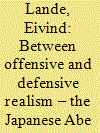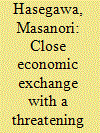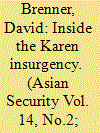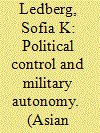|
|
|
Sort Order |
|
|
|
Items / Page
|
|
|
|
|
|
|
| Srl | Item |
| 1 |
ID:
160695


|
|
|
|
|
| Summary/Abstract |
This article gives a broad description of the Japanese second Abe government’s reassurance, arming, and alliance policy toward China. The sources used are mostly elite interviews, newspaper articles, and books from Japan. It gives a realist analysis but also looks at New Komeito’s influence within the coalition government on topics such as the adoption of principles for collective self-defense. While retaining major elements of the defensive realist Yoshida Doctrine, the direction of policy change has been toward a more assertive policy. Japanese perceptions of China’s capabilities and intentions and of the offensive or defensive advantage of the geography of the Nansei Islands and Chinese anti-ship ballistic missiles give an explanation for the shift in policy.
|
|
|
|
|
|
|
|
|
|
|
|
|
|
|
|
| 2 |
ID:
160693


|
|
|
|
|
| Summary/Abstract |
Chinese analysts view the US military not only as a model for emulation but also as a serious threat given its strengths in high tech weapons and equipment, power projection, and unparalleled ability to conduct information-intensive joint combat operations. Yet they also see many of the capabilities the US military relies upon to execute these operations – most notably forward bases, space capabilities, and computer networks and information technology systems – as potentially vulnerable to disruption. Accordingly, China has developed capabilities designed to deter or counter US military intervention in areas close to China. This poses two interrelated challenges for the United States: maintaining its military advantage in an era of rapid technological change and preserving deterrence against growing Chinese ambitions in Asia.
|
|
|
|
|
|
|
|
|
|
|
|
|
|
|
|
| 3 |
ID:
160694


|
|
|
|
|
| Summary/Abstract |
China’s rise presents a daunting dilemma for many Asia-Pacific states. What has not been fully appreciated is that many of China’s neighbors confront the dilemma of “close economic exchange with a threatening state” (CEETS). If they continue CEETS, it strengthens the threatening state’s economic and military power, jeopardizing their security. However, ending CEETS can cause their own economies to decline, deteriorating their national power and destabilizing their governments. Dominant theories such as realism and liberalism have not adequately explained security problems caused by CEETS, its origins, and potential countermeasures against it. This article examines these issues, focusing on the Asia-Pacific. Although there is no single panacea against CEETS dilemma, a regional agreement such as the Trans-Pacific Partnership (TPP) could be a promising countermeasure against it.
|
|
|
|
|
|
|
|
|
|
|
|
|
|
|
|
| 4 |
ID:
160692


|
|
|
|
|
| Summary/Abstract |
Successful multilateral economic, political or security cooperation as best exemplified by organizations such as the EU or ASEAN invites the question why comparable organizations have never been established in South Asia and the Indian Ocean Rim, two geo-strategically important world regions. This article foregoes political-realist arguments and offers an alternative explanation for the failure of regional multilateralism in those two regions by using the social-constructivist framework of norm localization. This framework, based upon third-generation norm diffusion, provides a new analytical toolbox for analysing the general puzzle why one region may accept a particular norm while rejecting another. Arguing the case for the existence of a special South Asian regional variation of multilateralism which is termed ‘Panchsheel-multilateralism’, the article examines the process of the localization of the global norm regional multilateralism and analyses how this norm became institutionalized in the form of the South Asian Association for Regional Cooperation (SAARC) and the Indian Ocean Rim Association (IORA). The main argument of the article is that the global norm of regional multilateralism has been localized into a principally Indian influenced model of multilateralism, based on the latter’s cognitive prior. Consequently, there has virtually never been room for any genuine multilateral cooperation, while tangible cooperative results are found in the bilateral domain only.
|
|
|
|
|
|
|
|
|
|
|
|
|
|
|
|
| 5 |
ID:
160691


|
|
|
|
|
| Summary/Abstract |
Why did the Pakistani military carry out genocidal violence against East Pakistani Hindus during the 1971 civil war when the Hindus did not constitute a security threat? This question carries not only theoretical but also important policy and security implications in present-day Bangladesh. A uniquely in-depth analysis of the little-known genocide in East Pakistan in 1971 shows that genocidal violence may be used as an instrument of nation-building. It was designed to mobilize both the Pakistani troops and the Bengali Muslim population against a convenient, well-defined enemy. The logic of othering – and then exterminating – a religious minority was meant to integrate a defiant, and previously marginalized, group into a reimagined community.
|
|
|
|
|
|
|
|
|
|
|
|
|
|
|
|
| 6 |
ID:
160696


|
|
|
|
|
| Summary/Abstract |
Debates about how states deal with rising powers have been mainly concentrated on a continuum comprising on balancing and bandwagoning strategies. While theory has principally offered realist and liberal explanations, Japanese behavior vis-à-vis China does not match with them. Japan is not powerful enough to balance against China but remains too strong to bandwagon. Accordingly, Tokyo is pursuing a mixed strategy of both containment and engagement, which may be better described as a hedging strategy against Beijing. This article analyzes which strategies states can adopt when dealing with a rising power and proposes a framework to analyze Japan’s recent policy towards China based on Kuik’s analysis. We argue that Japan’s hedging strategy towards China is consistent with how middle-power states deal with rising power.
|
|
|
|
|
|
|
|
|
|
|
|
|
|
|
|
| 7 |
ID:
160690


|
|
|
|
|
| Summary/Abstract |
Since 2012 Myanmar’s oldest ethnic rebel group, the Karen National Union (KNU), has sought for considerable rapprochement with the government. To many, this seemed to be the direct outcome of wider political transition in Myanmar. This article proposes an alternative explanation. Based on extensive field research and an emerging literature on armed groups, it demonstrates that the group’s rapprochement with the government was driven by leadership struggles between two rival factions within the KNU. At the core of this contestation are shifting internal power relations, which resulted from military pressures and geopolitical transformations in the Myanmar-Thai borderlands. These findings point to significant shortcomings of Myanmar’s peace process. They also contribute to the field of Conflict and Security Studies with much needed primary source data on the internal politics of insurgency, which shows how dynamics of civil war are driven by an interplay between forces on different levels of analysis.
|
|
|
|
|
|
|
|
|
|
|
|
|
|
|
|
| 8 |
ID:
160697


|
|
|
|
|
| Summary/Abstract |
The first part of this article discusses the most common theoretical and analytical approaches to the study of political control over the armed forces in China. It argues that the focus on professionalism and professionalization at the level of the military institution that is common in previous studies has certain limitations when analyzing Chinese civil–military relations. Against this background, the second part of the article suggests an alternative approach that places the Chinese officer corps and its professional autonomy at the center of analysis. Its benefit is demonstrated in a case study of quality control at China’s top three military education institutes. The study shows that autonomy and direct political control varies, which indicate a need for more nuanced discussions about military professionalization in China.
|
|
|
|
|
|
|
|
|
|
|
|
|
|
|
|
|
|
|
|
|